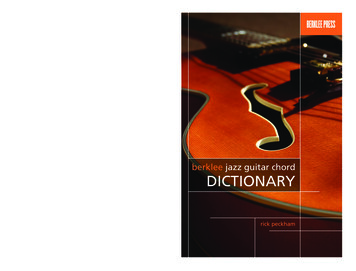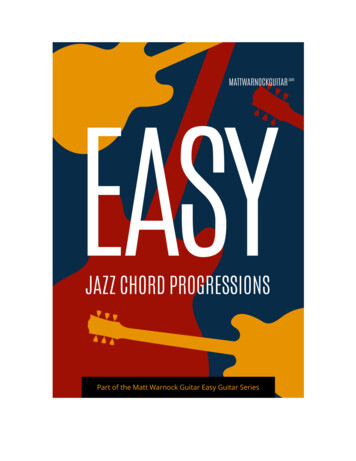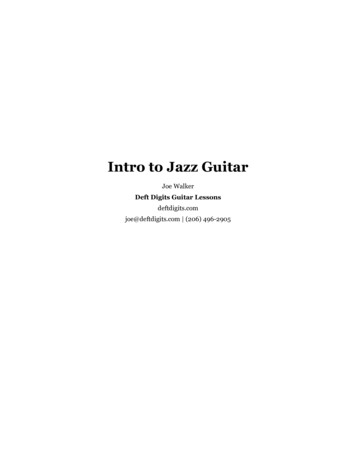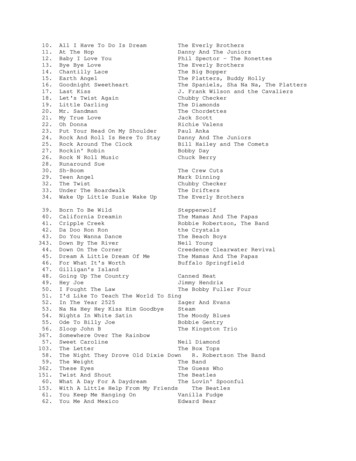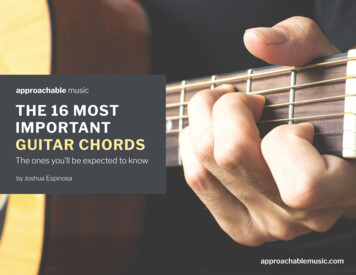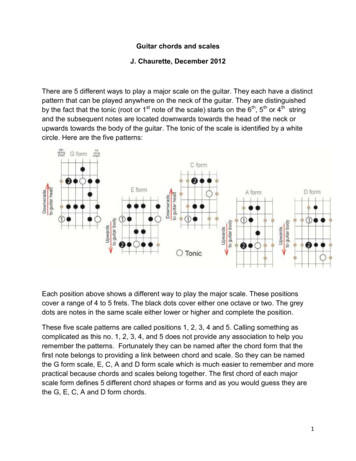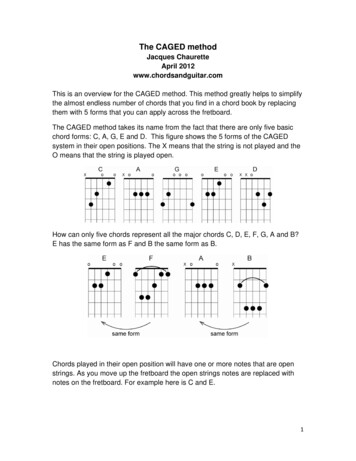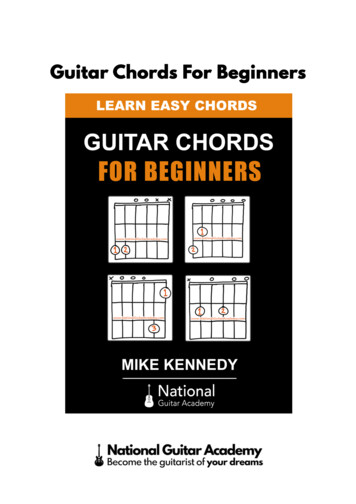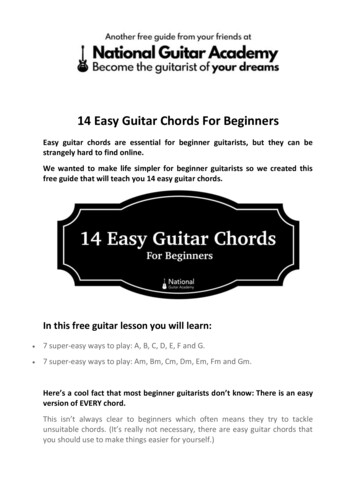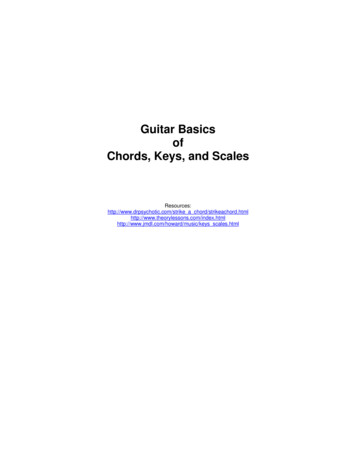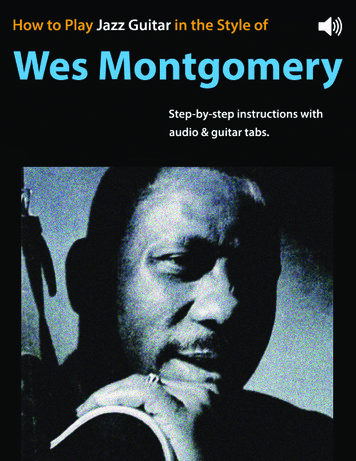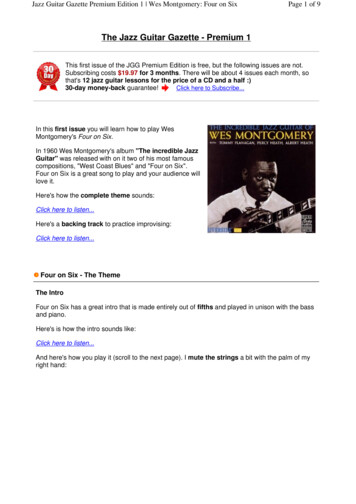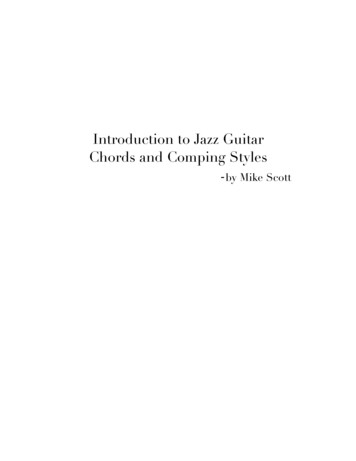
Transcription
Introduction to Jazz GuitarChords and Comping Styles-by Mike Scott
The following lessons introduce some of the basics of jazz guitar chords. Topics include:1. Some of the most common chord voicings used2. Intervals3. Triads4. Seventh Chords, Drop 2 and Drop 35. Extensions and Sus chords6. Quartal Chords7. Freddie Green Style8. Sample Comping Rhythms9. Bossa Nova Style10. Chords with Bass LineThe lessons will demonstrate an example in one key. Your assignment (what you need topractice!) is to learn to play them in all 12 keys. Some students have found they will need towrite out a few examples in other keys first, but then can start working through the rest in theirhead without writing them out. For example, in the triad section the lesson shows possibleways to play a C major triad. You will then want to learn those for Fmaj, Gmaj, Dmaj, etc.1. Practice it in the key that is shown first. Memorize it. Know the notes you are playing, not justthe shape!2. Choose another key to figure it out in. Many students will write it out at first. Memorize thatkey as well.3. Then choose another key and continue. Once you have done it in 3 or 4 keys the rest shouldget a lot easier.It's very important to learn the notes that are in each chord, not just the shape!Give yourself a grade! As you work on each topic, critique yourself and your progress. I givemy students the following self grading criteria for the triads as well as the drop 2 and 3 chords:A: You can play all the chord voicings and inversions (on all string sets) from memory andcould identify the notes in each chord.B: You can play the chords in the key of C from memory and you can identify some of thenotes in the chords. You can play some of the voicings in another key, but it takes you a littlewhile to figure out each new key and may need to write them out first. Not always sure of thenotes.C: You can play the voicings if you are looking at them and you could play them in another keyif you write them out. You don't have any of them memorized.D or F: You really can only read the tabs that written out.For the style lessons the idea is to learn what is written and then apply it to another song. Forexample, the Freddie Green style section gives an example over a blues and over the song "Allof Me". Once you can play those, choose another song and figure out on your own how to playFreddie Green style on that song.
Common Jazz Guitar ChordsIf you are somewhat new to jazz guitar chords, here are some of the most commonly used voicings.These chords are all shown with a C root found on the 5th or 6th string. They can easily be moved throughoutthe neck of the guitar by lining up the root with another desired note. For example, the first voicing for Cmaj7 hasit's root at the 3rd fret on the 5th string. To change this to a Dmaj7 you would move it up to the 5th fret.C maj7C maj73fr.C min7wwwwC min73fr.8fr.wb b wwwb b wwwwC min9C71fr.b b wwww7fr.b b wwwwbwb wwwC 138fr.1fr.1fr.C dim2fr.8fr.C 7(#9)C9C maj7 (#11)7fr.# wwwwC dimb wwwbwww1fr.wb wwwC7wb wwwbC min7 ( 5)7fr.b b b wwwwC min6/9b wwwwwb b wwwbC min7 ( 5)3fr.7fr.7fr.wwwwb b b wwwwC min61fr.b wwww1fr.8fr.wwwww& wwwC 6/9C 6/9C 7(#11)7fr.b # wwww
IntervalsAn interval is the distance between two notes. Intervals can be described as harmonic if the two notes soundsimultaneously or melodic if the two notes sound successively.half stepminor 2nd& b wwperfect 4th&ww&wwmajor 6thwhole stepmajor 2ndminor 3rdb wwwwtritoneaugmented 4thdiminished 5thbwwminor 7thwwbwwperfect 5thbww# wwmajor 3rdminor 6thwwwwmajor 7th1. Find intervals from notes other than C.2. Try playing different intervals on your guitar. (harmonic and melodic)wwoctave
TriadsA triad is a three note chord. The three notes are called the root, 3rd, and 5th. The intervals between thenotes are major or minor thirds. There are four types of triads: major, minor, diminished, augmented.C major triad& wwwminor 3rdmajor 3rdC minor triadb www major 3rdminor 3rdC diminished triadb b www minor 3rdminor 3rdC augmented triad# wwwmajor 3rdmajor 3rdC major triad: C (major 3rd) E (minor 3rd) GC minor triad: C (minor 3rd) Eb (major 3rd) GC diminished triad: C (minor 3rd) Eb (minor 3rd) GbC augmented triad: C (major 3rd) E (major 3rd) G#Triads can also be inverted. An inversion is a chord with a note other than the root on the bottom.First inversion has the third on the bottom, second inversion has the fifth on the bottom.C major triadroot position& wwwrootC minor triadroot position& b wwwrootwww3rdwwsecond inversionwwb wwb wwsecond inversionwfirst inversionfirst inversion3rdfifth5th
TriadsC major& œœœTABœœœ233578C minor& b œœœTABœœœ133568C diminished& b œœbœTAB132b œœœ468C augmented& œœ#œTAB234# 7b œœœ013546# œœœ123œœœ556œb b œœ10911œœœœœœœœœb œœœ8109œœœ567œœœ91010b œœœ81010b œœœœœœ10291011Assignment: Learn to do this in all 12 keys, memorized.555œb œœ101454# œœœ112b œœœ455bœb œœ111315œœœœœœb œœœ7810œœœ556œœœ8910œœœ8810œœœ010# œœœ9910355345888b b œœœ245œ# œœ011889œœœb œœœ131113œœœœœœœœœœœœ878# œœœ455b œœœ111312b œœœ111311œœœ899
Triads (Spread Voicings)C major& �5813531071410œœœœœœœœœ31851282510For spread voicings you will find there is more than one way to play them.The tablature here shows one possibilty. Try and find others.C minor& b œœœTABœœœbœœœ518512103811C diminished& b œœbœTABbœb œœ181C augmentedTABœ# œœ481353106131044311# œœœ529613104812Practice these in all 12 keys.œ# œœ# 1841114b œœbœ86bœœœ31875œbœœœœbœœœœb œœbœbœb œœ1110982& œœ#œb œœœœœœœœbœbœœœ# œœœœœ#œ1110œœœ41851292610
Triad Inversions on Guitar (Moving across strings)& c wwwC Majorroot positionTAB& b wwwwwwfirst inversionsecond inversionroot positionwb wwC Diminished& b b wwwwb b ww& # wwwb www# www567355b www345bwb wwb b www245454546468C Augmented555455556568678www557578C Minorwwww# ww556# www455
Diatonic Triads in the Major ScaleA triad can be built from each of the seven notes in the major scale. Diatonic triads use only notes belonging tothe scale. Each major scale/key will contain three major triads, three minor triads, and one diminished triad.Roman numerals are used to distinguish different triads (chords). Upper case for major, lower case for minor,lower case followed by a "o" for diminshed. Although it is not a diatonic triad in major keys, the augmentedtriad would be written as an upper case roman numeral followed by a " " sign.CmajorI& www#& rIwwwIn every key the I, IV and V chords are major. The ii, iii, and vi chords are minor and the viiº is diminished.Learn this in all 12 keys!
Diatonic Triads in C Major EminFmajGmajAminBdimCmaj457578791091012Root Position (on 5th, 4th, 3rd strings)& 44 5556778981010101212121314131516151717 21012131214& 9657 Cmaj2nd Inversion (on 6th, 5th, and 4th strings)& 13TAB 1st Inversion (on 4th, 3rd, 2nd strings)TAB Root Position (on 3rd, 2nd, 1st strings)TAB 121415 &5 101214 2121413This page shows 4 examples, but of course you can do any inversion on each of the 4 string sets.Practice this in all 12 keys!141515
Triads from the A Harmonic Minor Scale# # # EmajFmajG#dimAmin81010101213121314Root Position (on 3rd, 2nd, 1st strings) & 44 Amin012TABBdimCaugDmin134455567# EmajFmajG#dimAmin781091112101213121416141517 Bdim# Amin TAB235357678CaugDminAminTAB223& TAB# # # # CaugDminEmajFmajG#dim4355677789911101012131214 # # # EmajFmajG#dimAmin9991010101213121314141st Inversion (on 5th, 4th, 3rd strings)& Root Position (on 6th, 5th, 4th strings)& 799Bdim2nd Inversion (on 4th, 3rd, 2nd strings) AminBdimCaug122343556Dmin677Practice in all 12 keys!Amin141415
Triads from the A Melodic Minor Scale# # # BminCaugDmajRoot Position (on 3rd, 2nd, 1st strings) & 44 7# # AminEmajF#dim# # # 4576787910911121012141214161415171st Inversion (on 5th, 4th, 3rd strings)# Amin235223BminCaugDmaj# # # # # 1312142nd Inversion (on 4th, 3rd, 2nd strings)# Amin& TAB # & TAB455# Root Position (on 6th, 5th, 4th strings)& TAB234# # 122 # # # # # BminCaugDmajEmajF#dim344556777999Practice in all 12 keys!101110G#dim121312AminAmin141415 Amin131414
Seventh ChordsSeventh chords are triads with a note an interval of a seventh above the root added.There are five basic types of seventh chords: Major 7th, Dominant 7th, Minor 7th, Half-Diminished orMinor 7(b5), and Diminished 7th. With a C root the chords would be:C Major7: C E G BC7: C E G BbCminor7: C Eb G BbCø7 or Cminor7(b5): C Eb Gb BbCº7 or Cdim7: C Eb Gb Bbb(A)& wwwwb wwwwC Major7b b wwwwC7b b b wwwwCminor7Diatonic 7th ChordsC Maj7& wwwwI Maj7Dmin7wwwwii min7wwwwwwwwb b wwwwCø7wwwwwwwwCº7wwwwwwwwEmin7F Maj7G7Amin7Bø7C Maj7iii min7IV Maj7V7vi min7viiø7I Maj7Other types of 7th ChordsCmin(Maj7): C Eb G BC (Maj7) or C Maj7(#5): C E G# BC 7 or C7(#5): C E G# BbCdim(Maj7): C Eb Gb B& b wwwwCmin(Maj7)# wwwwC Maj7(#5)# b wwwwC7(#5)wb b wwwCdim(Maj7)
Like the triads, seventh chords can also have inversions.However,on guitar they are often very difficult to play, and many times just not possible.Try playing some of the following:C maj7C7b wwwwb wwwwwb wwwC min7b wwb wwb b wwwwwb b wwwC min7(b5)b b b wwwwb b b wwwwb b b wwwwwb b wwwb wb wwwb b wwww& wwww&wwwwwwwwwwwwRoot Positionb wwww& b b wwww& b b b wwwwC dim& b b wwww1st Inversion2nd Inversion3rd InversionThe above are referred to as close voicings. One way to make these work better on the guitar is to use what arecalled drop 2 and drop 3 voicings. A drop 2 voicing takes the second highest note of a close voicing and dropsit to the bass. A drop 3 voicing takes the third highest voice and drops it. For example:w& wwwCmaj7 2nd Inversionwwww Cmaj7 (drop 2)wwwwCmaj7 3rd Inversion wwwwCmaj7 (drop 3)
- Drop 2 Voicings Cmaj7 - Drop 2 Voicings& 44 wwwwTAB4233w& w& wwwTABwwww
C7 - Drop 2 Voicings& b wwww13TAB3233w& b www17TAB5353b wwww557698108213132wb www12101312b wwwwwwb ww119101013121413b wwwwwwb wwb wwww6555889812111210wb www8587w& b wwwTABwwb ww
Cmin7 - Drop 2 Voicings25TAB31335566bw& b www29TAB435388108wb wwb w8586wwbw&b w33TABb b wwwwwwbb ww& b b wwww3131bwb www6455wwbwb w12101311bwb wwwwwbb ww118101013121313wwbb wwb b wwww888811111210
& b b wwb ww37TAB3132414343b wb& b www45TABb b b wwwwwb b b www5466bw& b b wwwTABCmin7(b5) - Drop 2 Voicings21318898b wb wwb w7586b b wwwbw6454b wb b www11101311bwb wwbwwb b b www11810913111313wb b b www8788b b b wwww11111110
C, Eb, Gb, or A Diminished - Drop 2 Voicings& b wwb ww49TAB2132bw& b www53TAB57TAB5465bwwb ww4243b ww& b ww2121bwb wwwwb b www7576b wwwbw54548798b wwb ww11101211b wwwbwwb b www10810913111312wb b www8787Practice all of the drop 2 chords in all 12 keys!b wb www11101110
Drop 3 chordswwww& 44 wwwwwwwwwwwwTAB14255589912121037812Cmaj7 on strings 6,4,3,2TABwwww3547858129121312371014wb www13255589811121036812b wwwwb wwwwww& b wwC7 on strings 5,3,2,1TABwwwbw3536858119121312371013& b b wwwwCmin7 on strings 6,4,3,2TABb wwwwwwwbw& b wwwwC7 on strings 6,4,3,2TABwwwwwwwwww& wwCmaj7 on strings 5,3,2,1b wwwbwwb b wwwb wwwbw13145588811121036811
TABwb b www3436858118111312361013& b b wwwbwb b wwwbwb b b wwwwbwb wwbwCmin7(b5) on strings 6,4,3,2TABb wwwbwDrop 3 (page 2)b wwwbwb ww& b wwCmin7 on strings 5,3,2,1131454788111110268bwb wwbwb b b www&wCmin7(b5) on strings 5,3,2,1b b wwwbwb wwb wb w11243675811811131136913& b wwwbwbwb wwwTABCdim on strings 6,4,3,2TABb wwwb w12145478710111025811Cdim on strings 5,3,2,1b wwb b www& wbwwTABb b wwwwwb wwbwbwb www242575810811131136912Practice in all 12 keys!
Common Chord ExtensionsSome common extensions on major chords would include the 6th, the 9th, and the #11.wwww& 44 wwwwC6TAB5253C6wwwwwC Maj9wwwwwwww66C Maj7wwwwC9C93423322387781. As with the seventh chords, it can be difficult to play these extended chords in root position onguitar and include every note. Notice the second voicing for C6 moves the E up an octave.2. The fifth can often be omitted (as well as other chord tones) to make room for the extensions.Compare the two voicings for CMaj9 (5th omitted in 2nd). In the second voicing for C6/9 the third is omitted.3. Both the 6th and the 9th are diatonic tones and can be included with any major seventh voicing.4. Notice that C6 uses the same chord tones as Amin7. So all of those drop 2's and drop 3's for Amin7could also be possible voicings for C6. A similar thing happens with CMaj9. If you take away the root youwould be left with Emin7. You could then use drop 2 and 3 Emin7 voicings as options for CMaj9.The #11 is also a common extension on Major 7th chords in jazz. On the I chord it is a non-diatonic tone,but on the IV chord it is a diatonic tone. The #11 could also be referred to as a #4 or b5. (see below)#w& wwww6C 9 (#11)TAB# wwwww# wwwww# www234237995443C Maj9(#11)23223C Maj7(#11)C Maj7(#4)8The 6th and the 9th are also very common extensions on minor chords.&TABC min6b wwwwb wwwwC min64253b wwwwC min68878wb b wwwwC min9wb b wwwC min93313wb www6C min 93213
The 6th and 9th work well with the min(Maj7) chord as well.&b wwwwb wwwwwb wwwb wwwwTAB0013445334130213C min(Maj7)C min(Maj7)C min9(Maj7)C min6(Maj7)b wwwwwb wwww88
If you are somewhat new to jazz guitar chords, here are some of the most commonly used voicings. These chords are all shown with a C root found on the 5th or 6th string. They can easily be moved throughout the neck of the guitar by lining up the root with another desired note. For example, the first voicing for Cmaj7 has it's root at the 3rd fret on the 5th string. To change this to a Dmaj7 .
